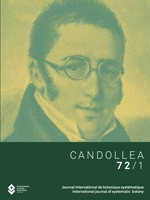Eva Maier (18 August 1928 – 27 November 2017) had an enquiring mind, a curious nature, a generous heart and an enthusiasm for life, but she also possessed a tenacious spirit that meant she left no stone unturned when in pursuit of answers to her questions. Eva was a woman before her time. She trained to become a biochemist and worked in the chemical industry just after the Second World War, developing her critical scientific thinking as well as her keen interest in the world around her. She moved to Geneva, Switzerland from her native Germany in the early 1960's when her husband, Hermann, began his career at CERN. She continued to pursue her diverse interests in biology, the arts and literature, learning French, as well as Russian, during her first years in her adopted, and beloved, new country. A keen botanist since childhood, Eva first became interested in mosses during the 1980's through her friends Vera and Johannes Geibel, who were involved in the Swiss Bryological and Lichenological Association (Bryolich) at that time. She went on to become an active member of Bryolich and the National Inventory of Swiss Bryophytes (NISM) project, based at the Institute of Systematic Botany, University of Zürich. Eva and her husband Hermann travelled widely within Switzerland during their summer holidays and Eva developed an in depth knowledge of the Swiss bryophyte flora. The Hermann and Eva Maier herbarium, with around 10,000 accessions, was donated by Eva to the institution in 2005.
In 1989 Eva began to work with the late Dr. Patricia Geissler (1947–2000), curator of cryptogams, at the Conservatory and Botanical Garden of the City of Geneva (CJBG) as a scientific collaborator. She was interested in the genus Tortula Hedw. and later in Grimmia Hedw., which became the focus of her research activities. Alongside her collecting activities, Eva was interested in the morphology and anatomy of mosses, and specifically how careful but critical observation of specimens could lead to a better understanding of the systematic relationships and species circumscriptions in this group of plants. In 2010 Eva published her highly praised treatment of Grimmia in the journal Boissiera. This work is a strong testimony to her skill as a scientist and to her deep understanding of the genus based on 20 years of careful observation of specimens of Grimmia from herbaria from all over the world.
Eva was always available to help those around her, sharing her botanical and bryological expertise as well as her time and her rich life-experiences. Eva was greatly appreciated within the Department of Cryptogamy, headed by Dr. Philippe Clerc, where her colleagues, including Jocelyne Perrenoud, Agathe Gautschi, Michèle Gendre and Isabella Valette, valued her help, but especially her warmth, her enthusiasm and her kindness. Eva has also influenced several generations of young scientists that have studied bryology at the CJBG : Dr. Anne Streiff who worked on the phylogeny of Grimmia; Dr. Ariane Cailliau, Laurent Burgisser and Hélène Hinden - who work on the bryophytes of the canton of Geneva ; Dr. Annick Lang an expert in Dicranum ; Dr. Karen Martinez who worked on rare bryophytes in Switzerland; Gabriela Loza Steinbach who studied mosses from South America and discovered her gift for botanical illustration; and, more recently Amanda Guerreiro, who worked on the anatomy of peristomes of mosses and is now doing a PhD in the Faculty of Medicine at the University of Geneva. Eva's ability to read old German texts and decipher all sorts of, often intangible, handwriting on herbarium labels was invaluable to the success of the bryophyte types scanning project, funded by the Andrew W. Mellon Foundation. Eva took the students and collaborators in bryology under her wing and was always delighted to see the young people around her developing an interest in bryophytes, and growing as young scientists.
We, and I, greatly value the contribution that Eva Maier has made to the scientific strength of the institution and to the Cryptogamic Herbarium over the years. Eva leaves behind her a legacy of careful scientific observations of mosses, of rigorous thinking, and many pertinent contributions to bryology. Eva will be greatly missed by all who knew her. Many people's lives were greatly enriched by her in many different ways, and we were honoured to have her as a scientific collaborator and colleague here at the Conservatoire et Jardin botaniques de la Ville de Genève.






